Ford F 53 Motorhome Chassis 2001 Owner's Manual
|
Table of contents |
|
|
Introduction |
2 |
|
|
|
|
Instrumentation |
6 |
|
|
|
|
Controls and features |
15 |
|
|
|
|
Starting |
22 |
|
|
|
|
Driving |
27 |
|
|
|
|
Roadside emergencies |
39 |
|
|
|
|
Maintenance and care |
57 |
|
|
|
|
Capacities and specifications |
93 |
|
|
|
|
Customer Assistance |
98 |
|
|
|
|
Reporting Safety Defects |
99 |
|
|
|
|
Index |
100 |
|
|
All rights reserved. Reproduction by any means, electronic or mechanical including photocopying, recording or by any information storage and retrieval system or translation in whole or part is not permitted without written authorization from Ford Motor Company. Ford may change the contents without notice and without incurring obligation.
Copyright © 2000 Ford Motor Company
1
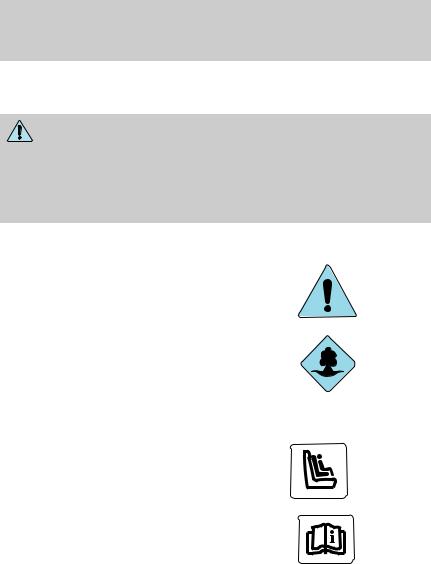
Introduction
The following warning may be required by California law:
CALIFORNIA Proposition 65 Warning
WARNING: Engine exhaust, some of its constituents, and certain vehicle components contain or emit chemicals known to
the State of California to cause cancer and birth defects or other reproductive harm. In addition, certain fluids contained in vehicles and certain products of component wear contain or emit chemicals known to the State of California to cause cancer and birth defects or other reproductive harm.
ICONS
Indicates a safety alert. Read the following section on Warnings.
Indicates vehicle information related to recycling and other environmental concerns will follow.
Correct vehicle usage and the authorized disposal of waste
cleaning and lubrication materials are significant steps towards protecting the environment.
Indicates a message regarding child safety restraints. Refer to Seating and safety restraints for more information.
Indicates that this Owner Guide contains information on this subject. Please refer to the Index to locate the appropriate section which will provide you more information.
2

Introduction
WARNINGS
Warnings provide information which may reduce the risk of personal injury and prevent possible damage to others, your vehicle and its equipment.
BREAKING-IN YOUR VEHICLE
There are no particular breaking-in rules for your vehicle. During the first 1 600 km (1 000 miles) of driving, vary speeds frequently. This is necessary to give the moving parts a chance to break in.
INFORMATION ABOUT THIS GUIDE
The information found in this guide was in effect at the time of printing. Ford may change the contents without notice and without incurring obligation.
SPECIAL NOTICES
Notice to owners of Class A Motorhome Vehicles
The Ford Motorhome Chassis is not suitable for producing ambulances or school buses. In addition, Ford urges manufacturers to follow the recommendations of the “Ford Incomplete Vehicle Manual,” the “Ford Truck Body Builder’s Layout Book,” and other pertinent supplements.
Notification of delayed warranty start date and accumulated mileage
Verify that your recreational vehicle dealer has submitted a Notification of Delayed Warranty Start Date and Accumulated Mileage (FCS 900) to Ford Motor Company.
3

Introduction
These are some of the symbols you may see on your vehicle.
Safety Alert |
See Owner’s Guide |
|
Fasten Safety Belt |
Air Bag-Front |
|
Air Bag-Side |
Child Seat |
|
Child Seat Installation |
Child Seat Tether |
|
Warning |
Anchorage |
|
Brake System |
Anti-Lock Brake System |
|
Brake Fluid - |
Traction Control |
|
Non-Petroleum Based |
||
|
||
Master Lighting Switch |
Hazard Warning Flasher |
|
Fog Lamps-Front |
Fuse Compartment |
|
Fuel Pump Reset |
Windshield Wash/Wipe |
|
Windshield |
Rear Window |
|
Defrost/Demist |
Defrost/Demist |
|
Power Windows |
Power Window Lockout |
|
Front/Rear |
||
|
||
Child Safety Door |
Interior Luggage |
|
Compartment Release |
||
Lock/Unlock |
||
Symbol |
||
|
||
4 |
|

Introduction
Panic Alarm |
Engine Oil |
Engine Coolant
Engine Coolant
Temperature
Do Not Open When Hot |
Battery |
Avoid Smoking, Flames,
Battery Acid
or Sparks
Explosive Gas |
Fan Warning |
Power Steering Fluid
Maintain Correct Fluid
Level
Emission System |
Engine Air Filter |
|
Passenger Compartment |
Jack |
|
Air Filter |
||
|
MAX
MIN
Check fuel cap
5
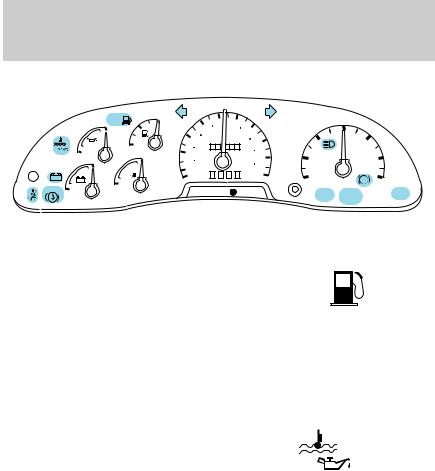
Instrumentation
WARNING LIGHTS AND CHIMES
BRAKE
 !
! 
|
L |
+- |
18 |
|
+- |
BRAKE |
8 |
|
|
|
50 |
60 |
|
|
|
|
LOW |
|
40 |
|
100 70 |
|
|
3 |
|
FUEL |
F |
|
80 |
|
|
|
||
|
|
|
|
|
2 |
|
4 |
|
H |
30 |
60 |
|
120 |
80 |
|
||
|
|
|
|
|
|
|||
E |
20 |
40 |
0 0 0 0 0 0 |
|
|
|
|
|
|
|
|
140 |
|
|
|
5 |
|
|
|
|
|
90 |
1 |
|
||
|
|
20 |
|
|
|
|||
|
|
|
|
|
|
|
|
|
H |
10 |
|
|
180 |
|
|
|
|
MPH 0 0 0 |
0 km/h |
100 |
0 |
|
6 |
|||
C |
0 |
ABS |
||||||
|
P |
R N |
2 1 |
|
RPMx1000 |
|
||
|
|
|
FUEL |
SERVICE |
DOOR |
|||
|
|
|
|
|
|
RESET |
ENGINE |
AJAR |
SOON
Low fuel
Illuminates as an early reminder of a
low fuel condition indicated on the fuel gauge (refer to Fuel Gauge in
this chapter for more information). When refueling, after the light
comes on, the amount of fuel that is added will be less than the advertised capacity since there is fuel still in the tank. The ignition must be in the ON position for this lamp to illuminate. The lamp will also illuminate for several seconds after the ignition is turned to the ON position regardless of the fuel level to ensure your bulb is working.
Oil pressure/Engine coolant
This light will come on when the key is in the ON position and the:
• engine coolant temperature is very high
• engine oil pressure is low
The light serves as a notice that a system needs your attention and to check the engine coolant temperature gauge and the engine oil pressure gauge.
Refer to Engine coolant temperature gauge and Engine oil pressure gauge in this chapter for more information.
6
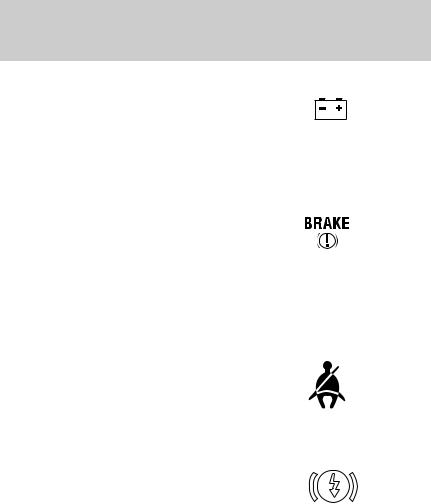
Instrumentation
Charging system
Illuminates when the ignition is turned to the ON position and the engine is off. The light also illuminates when the battery is not charging properly, requiring electrical system service.
Brake system warning
Momentarily illuminates when the ignition is turned to the ON position
to ensure the circuit is functional. Also illuminates if the parking brake
is engaged. If the brake warning
lamp does not illuminate at these times, seek service immediately. Illumination after releasing the parking brake indicates low brake fluid level and the brake system should be inspected immediately.
Safety belt
Momentarily illuminates when the ignition is turned ON to remind you to fasten your safety belts.
Brake reserve system warning (if equipped)
Illuminates to indicate normal |
BRAKE |
Hydromax booster reserve system |
|
activation when the engine is OFF |
|
and the service brake pedal is |
|
applied, or when the ignition is in |
|
the ON or START position. |
|
This light may also illuminate momentarily if the engine is running and the driver turns the steering wheel fully in one direction while braking.
If the light remains on while the engine is running, this indicates inadequate hydraulic booster pressure or reserve pump system failure. Safely stop the vehicle as soon as possible and seek service immediately.
7

Instrumentation
Service engine soon
Your vehicle is equipped with a computer that monitors the engine’s emission control system. This system is commonly known as the On Board Diagnostics System (OBD). This OBD system protects
the environment by ensuring that your vehicle continues to meet government emission standards. The OBD system also assists the service technician in properly servicing your vehicle.
The Service Engine Soon indicator light illuminates when the ignition is first turned to the ON position to check the bulb. If it comes on after the engine is started, one of the engine’s emission control systems may be malfunctioning. The light may illuminate without a driveability concern being noted. The vehicle will usually be drivable and will not require towing.
What you should do if the Service Engine Soon light illuminates
Light turns on solid:
This means that the OBD system has detected a malfunction.
Temporary malfunctions may cause your Service Engine Soon light to illuminate. Examples are:
1.The vehicle has run out of fuel. (The engine may misfire or run poorly.)
2.Poor fuel quality or water in the fuel.
3.The fuel cap may not have been properly installed and securely tightened.
These temporary malfunctions can be corrected by filling the fuel tank with high quality fuel of the recommended octane and/or properly installing and securely tightening the gas cap. After three driving cycles without these or any other temporary malfunctions present, the Service Engine Soon light should turn off. (A driving cycle consists of a cold engine startup followed by mixed city/highway driving.) No additional vehicle service is required.
If the Service Engine Soon light remains on, have your vehicle serviced at the first available opportunity.
8
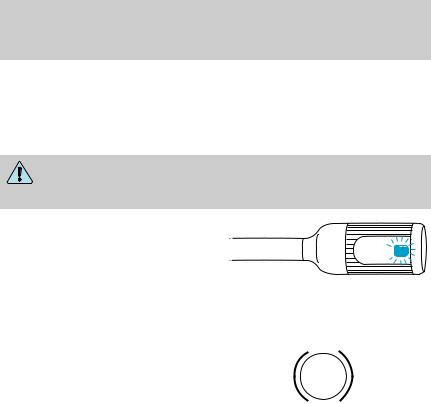
Instrumentation
Light is blinking:
Engine misfire is occurring which could damage your catalytic converter. You should drive in a moderate fashion (avoid heavy acceleration and deceleration) and have your vehicle serviced at the first available opportunity.
Under engine misfire conditions, excessive exhaust temperatures could damage the catalytic converter, the fuel system, interior
floor coverings or other vehicle components, possibly causing a fire.
The Transmission Control Indicator
Light (TCIL), which is located on
the gearshift lever (the word OFF), OVERDRIVE 


 may flash steadily if a transmission
may flash steadily if a transmission
malfunction has been detected. It
the TCIL is flashing, contact your Ford dealer as soon as possible. If this condition persists, damage to the transmission may occur.
Anti-lock brake system (ABS) (if equipped)
Momentarily illuminates when the
ignition is turned to the ON position ABS to ensure the circuit is functional. If
the light remains on after the vehicle is started, continues to flash
or fails to illuminate, have the system serviced immediately. With the ABS light on, the anti-lock brake system is disabled and normal braking is still effective unless the brake warning light also remains illuminated.
Door ajar (if equipped)
Illuminates when the ignition switch is in the ON or START position and any door is open.
DOOR AJAR
9

Instrumentation
Fuel reset
Illuminates when the ignition is turned to the ON position and the fuel pump shut-off switch has been triggered. For more information, refer to Fuel pump shut-off switch
in the Roadside emergencies chapter.
High beams
Illuminates when the high beam headlamps are turned on.
Turn signal
Illuminates when the left or right turn signal or the hazard lights are turned on. Refer to Bulbs in the
Maintenance and care chapter.
FUEL RESET
Safety belt warning chime (if equipped) 
Sounds to remind you to fasten your safety belts.
Key-in-ignition warning chime (if equipped)
Sounds when the key is left in the ignition in the OFF/LOCK or ACC position and the driver’s door is opened.
Headlamps on warning chime (if equipped)
Sounds when the headlamps or parking lamps are on, the ignition is off (and the key is not in the ignition) and the driver’s door is opened.
10
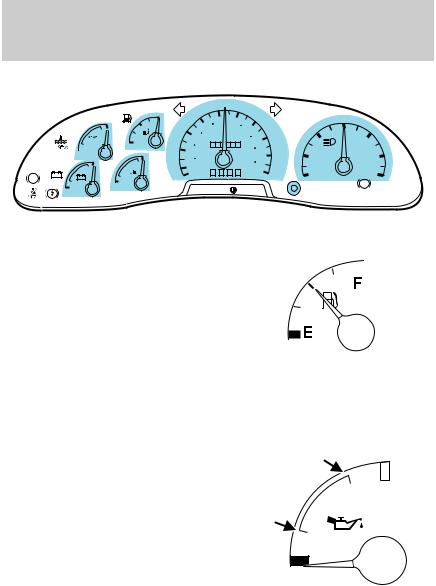
Instrumentation
GAUGES
BRAKE |
- |
+ |
|
! |
|||
|
|
BRAKE
 L
L
18 - +
8
|
|
|
50 |
60 |
|
|
|
|
LOW |
|
40 |
|
100 70 |
|
|
3 |
|
FUEL |
F |
|
80 |
|
|
|
||
|
|
|
|
|
2 |
|
4 |
|
H |
30 |
60 |
|
120 |
80 |
|
||
|
|
|
|
|
|
|||
E |
20 |
40 |
0 0 0 0 0 0 |
|
|
|
|
|
|
|
|
140 |
|
|
|
5 |
|
|
|
|
|
90 |
1 |
|
||
|
|
20 |
|
|
|
|||
|
|
|
|
|
|
|
|
|
H |
10 |
|
|
180 |
|
|
|
|
MPH 0 0 0 |
0 km/h |
100 |
0 |
|
6 |
|||
C |
0 |
|
||||||
|
P |
R N |
2 1 |
|
RPMx1000 |
ABS |
||
|
|
|
FUEL |
SERVICE |
DOOR |
|||
|
|
|
|
|
|
RESET |
ENGINE |
AJAR |
SOON
Fuel gauge
Displays approximately how much fuel is in the fuel tank (when the
key is in the ON position). The ignition should be in the OFF position while the vehicle is being refueled. When the gauge first indicates empty, there is a small
amount of reserve fuel in the tank. When refueling the vehicle from empty indication, the amount of fuel
that can be added will be less than the advertised capacity due to the reserve fuel.
Engine oil pressure gauge
This shows the engine oil pressure in the system. Sufficient pressure exists as long as the needle remains in the normal range (the area between the “L” and “H”).
H
If the gauge indicates low pressure, |
|
stop the vehicle as soon as safely |
L |
possible and switch off the engine |
immediately. Check the oil level. Add oil if needed (refer to Engine oil in the Maintenance and care
chapter). If the oil level is correct, have your vehicle checked at your dealership or by a qualified technician.
11

Instrumentation
Battery voltage gauge
This shows the battery voltage when the ignition is in the ON position. If the pointer moves and stays outside the normal operating range (as indicated), have the vehicle’s electrical system checked as soon as possible.
Engine coolant temperature gauge
Indicates the temperature of the engine coolant. At normal operating temperature, the needle remains within the normal area (the area between the “H” and “C”). If it enters the red section, the engine is overheating. Stop the vehicle as soon as safely possible, switch off the engine immediately and let the engine cool. Refer to Engine coolant in the Maintenance and care chapter.
18

 8
8
H
C
Never remove the coolant reservoir cap while the engine is running or hot.
This gauge indicates the temperature of the engine coolant, not the coolant level. If the coolant is not at its proper level the gauge indication will not be accurate.
12

Instrumentation
Speedometer
Indicates the current vehicle speed.
Odometer
Registers the total kilometers (miles) of the vehicle.
Trip odometer |
|
|
|
|
Registers the kilometers (miles) of |
|
50 |
60 |
|
individual journeys. To reset, |
40 |
70 |
|
|
depress the control. |
|
|
|
|
|
80 |
|
|
|
30 |
|
100 |
80 |
|
|
60 |
|||
|
|
120 |
||
|
|
|
|
|
20 |
40 |
0 0 0 0 0 0 |
|
|
|
140 |
90 |
||
|
|
|
||
10 |
20 |
|
0 km/h 160 |
|
|
MPH 0 0 0 |
100 |
||
0 |
|
|
|
|
13

Instrumentation
Tachometer
Indicates the engine speed in revolutions per minute.
Driving with your tachometer pointer continuously at the top of the scale may damage the engine.
14

HEADLAMP CONTROL 


Rotate the headlamp control to the first position to turn on the parking lamps. Rotate to the second position to also turn on the headlamps.
Controls and features
P
Daytime running lamps (DRL) (if equipped)
The daytime running light system turns the headlamps on, with a reduced light output, when:
•the vehicle is running and
•the headlamp system is in the OFF position or parking lamp position.
Always remember to turn on your headlamps at dusk or during inclement weather. The Daytime Running Light (DRL) System
does not activate your tail lamps and generally may not provide adequate lighting during these conditions. Failure to activate your headlamps under these conditions may result in a collision.
High beams 

Push forward to activate.
Pull toward you to deactivate.
15

Controls and features
Flash to pass
Pull toward you to activate and release to deactivate.
PANEL DIMMER CONTROL |
|
Use to adjust the brightness of the |
PANEL |
instrument panel during headlamp |
DIM |
and parklamp operation. |
|
• Rotate up to brighten. |
|
• Rotate down to dim. |
|
• Rotate to full up position (past |
|
detent) to turn on interior lamps. |
|
POSITIONS OF THE IGNITION |
|
1. ACCESSORY, allows the electrical |
|
accessories such as the radio to |
2 |
operate while the engine is not |
|
running. |
|
2. LOCK, locks the automatic |
|
transmission gearshift lever and |
1 |
allows key removal. |
3. OFF, shuts off the engine and all accessories without locking the steering wheel.
3
4
5
4.ON, all electrical circuits operational. Warning lights illuminated. Key position when driving.
5.START, cranks the engine. Release the key as soon as the engine starts.
16
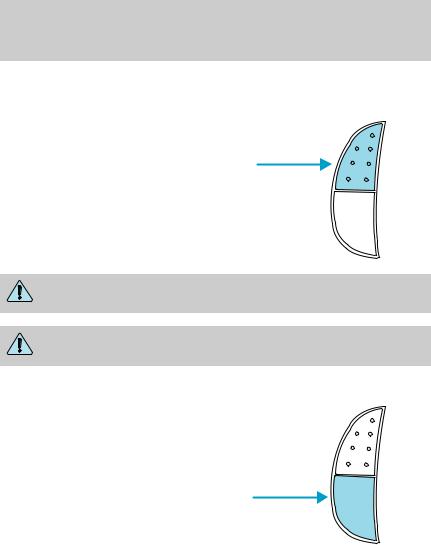
SPEED CONTROL
To turn speed control on
• Press ON.
Vehicle speed cannot be controlled until the vehicle is traveling at or above 48 km/h (30 mph).
Controls and features
ON
OFF
Do not use the speed control in heavy traffic or on roads that are winding, slippery, or unpaved.
Do not shift the gearshift lever into N (Neutral) with the speed control on.
To turn speed control off
•Press OFF or
•Turn off the vehicle ignition.
ON
OFF
Once speed control is switched off, the previously programmed set speed will be erased.
17
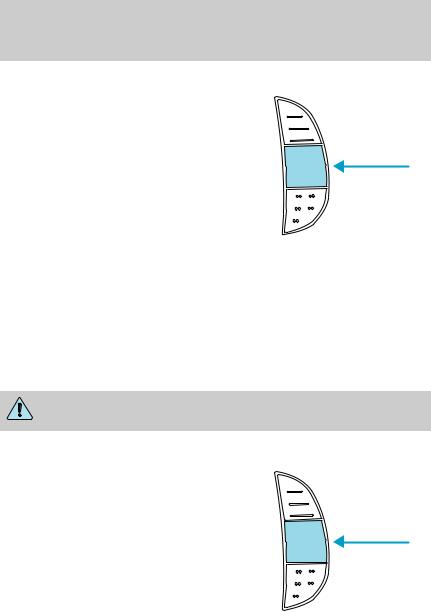
Controls and features
To set a speed
•Press SET ACCEL. For speed control to operate, the speed control must be ON and the vehicle speed must be greater than 48 km/h (30 mph).
RES
SET ACCEL
COAST
If you drive up or down a steep hill, your vehicle speed may vary momentarily slower or faster than the set speed. This is normal.
Speed control cannot reduce the vehicle speed if it increases above the set speed on a downhill. If your vehicle speed is faster than the set speed while driving on a downhill, you may want to shift to the next lower gear or apply the brakes to reduce your vehicle speed.
If your vehicle slows down more than 16 km/h (10 mph) below your set speed on an uphill, your speed control will disengage. This is normal. Pressing RES will re-engage it.
Do not use the speed control in heavy traffic or on roads that are winding, slippery, or unpaved.
To set a higher set speed
•Press and hold SET ACCEL. Release the control when the desired vehicle speed is reached or
RES
•Press and release SET ACCEL to operate the Tap-Up function. Each press will increase the set speed by 1.6 km/h (1 mph) or
SET ACCEL
COAST
•Accelerate with your accelerator pedal. When the desired vehicle
speed is reached, press and release SET ACCEL.
18

Controls and features
You can accelerate with the accelerator pedal at any time during speed control usage. Releasing the accelerator pedal will return your vehicle to the previously programmed set speed.
To set a lower set speed
•Press and hold COAST. Release the control when the desired speed is reached or
•Press and release COAST to operate the Tap-Down function. Each press will decrease the set speed by 1.6 km/h (1 mph) or
RES
SET ACCEL
COAST
•Depress the brake pedal. When the desired vehicle speed is reached, press SET ACCEL.
RES
SET ACCEL
COAST
To disengage speed control
• Depress the brake pedal.
Disengaging the speed control will not erase the previously programmed set speed.
19

Controls and features
Pressing OFF will erase the previously programmed set speed.
ON
OFF
To return to a previously set speed
•Press RES. For RES to operate, the vehicle speed must be faster than 48 km/h (30 mph).
RES
SET ACCEL
COAST
HAZARD FLASHER 
For information on the hazard flasher control, refer to Hazard flasher in the Roadside emergencies chapter.
WINDSHIELD WIPER/WASHER CONTROLS 
Rotate the windshield wiper control to the desired interval, low or high speed position.
The bars of varying length are for intermittent wipers. When in this position rotate the control upward for fast intervals and downward for slow intervals.
20
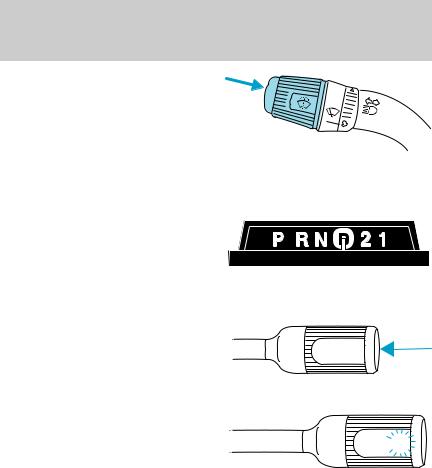
Controls and features
Push the control on the end of the stalk to activate washer. Push and hold for a longer wash cycle. The washer will automatically shut off after ten seconds of continuous use.
OVERDRIVE CONTROL
Activating overdrive
 (Overdrive) is the normal drive position for the best fuel economy.
(Overdrive) is the normal drive position for the best fuel economy.
The overdrive function allows automatic upshifts to second, third and fourth gear.
Deactivating overdrive
Press the Transmission Control Switch (TCS) located on the end of the gearshift lever. The Transmission Control Indicator Light (TCIL) (the word OFF) will
illuminate on the end of the gearshift lever.
The transmission will operate in all gears except overdrive. To return to normal overdrive mode, press the Transmission Control Switch again. The TCIL (the word OFF) will no longer be illuminated.
OVERDRIVE OFF
OVERDRIVE 
When you shut off and re-start your vehicle, the transmission will automatically return to normal  (Overdrive) mode.
(Overdrive) mode.
For additional information about the gearshift lever and the transmission control switch operation refer to the Automatic Transmission Operation section of the Driving chapter.
21

Starting
PREPARING TO START YOUR VEHICLE
Engine starting is controlled by the powertrain control system. This system meets all Canadian Interference-Causing Equipment standard requirements regulating the impulse electrical field strength of radio noise.
When starting a fuel-injected engine, avoid pressing the accelerator before or during starting. Only use the accelerator when you have difficulty starting the engine. For more information on starting the vehicle, refer to Starting the engine in this chapter.
Extended idling at high engine speeds can produce very high temperatures in the engine and exhaust system, creating the risk
of fire or other damage.
Do not park, idle, or drive your vehicle in dry grass or other dry ground cover. The emission system heats up the engine
compartment and exhaust system, which can start a fire.
Do not start your vehicle in a closed garage or in other enclosed  areas. Exhaust fumes can be toxic. Always open the garage door before you start the engine. See Guarding against exhaust fumes in
areas. Exhaust fumes can be toxic. Always open the garage door before you start the engine. See Guarding against exhaust fumes in
this chapter for more instructions.
If you smell exhaust fumes inside your vehicle, have your dealer inspect your vehicle immediately. Do not drive if you smell
exhaust fumes.
22

Starting
Important safety precautions
A computer system controls the engine’s idle revolutions per minute (RPM). When the engine starts, the idle RPM runs faster to warm the engine. If the engine idle speed does not slow down automatically, have the vehicle checked. Do not allow the vehicle to idle for more than 10 minutes.
Before starting the vehicle:
1.Make sure all vehicle occupants have buckled their safety belts.
2.Make sure the headlamps and vehicle accessories are off.
3.Make sure the parking brake is
set.
4. |
Make sure the gearshift is in P |
|
|
|
(Park). |
|
|
|
|
|
|
|
||
5. |
Turn the key to 4 |
(ON) without |
|
|
|
|
|||
turning the key to 5 |
(START). |
4 |
||
|
|
|
||
If there is difficulty in turning the |
3 |
|
||
key, firmly rotate the steering wheel |
5 |
|||
left and right until the key turns |
||||
|
|
|
||
freely. This condition may occur |
2 |
|
|
|
|
|
|||
when: |
|
|
|
|
• front wheels are turned |
1 |
|
||
• front wheel is against the curb |
|
|
|
|
23
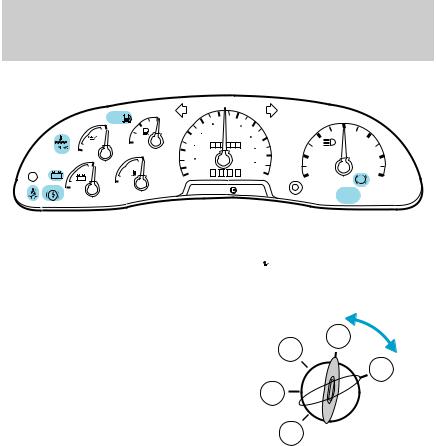
Starting
• steering wheel is turned when getting in or out of the vehicle
BRAKE
 !
! 
|
L |
+- |
18 |
|
+- |
BRAKE |
8 |
|
|
|
50 |
60 |
|
|
|
|
LOW |
|
40 |
|
100 70 |
|
|
3 |
|
FUEL |
F |
|
80 |
|
|
|
||
|
|
|
|
|
2 |
|
4 |
|
H |
30 |
60 |
|
120 |
80 |
|
||
|
|
|
|
|
|
|||
E |
20 |
40 |
0 0 0 0 0 0 |
|
|
|
|
|
|
|
|
140 |
|
|
|
5 |
|
|
|
|
|
90 |
1 |
|
||
|
|
20 |
|
|
|
|||
|
|
|
|
|
|
|
|
|
H |
10 |
|
|
180 |
|
|
|
|
MPH 0 0 0 |
0 km/h |
100 |
0 |
|
6 |
|||
C |
0 |
|
||||||
|
|
|
|
RPMx1000 |
ABS |
|||
|
P |
R N |
2 1 |
|
|
|||
|
|
|
FUEL |
SERVICE |
DOOR |
|||
|
|
|
|
|
|
RESET |
ENGINE |
AJAR |
|
|
|
|
|
|
|
SOON |
|
Make sure the corresponding lights illuminate briefly. If a light fails to illuminate, have the vehicle serviced.
• If the driver’s safety belt is fastened, the  light may not illuminate.
light may not illuminate.
STARTING THE ENGINE
1.Turn the key to 5 (START) without pressing the accelerator pedal and release as soon as the engine starts. The key will return to
4(ON).
2.If the temperature is above –12°C (10°F) and the engine does not start within five seconds on the first try, turn the key to OFF, wait 10 seconds and try again.
4
3
5
2
1
3.If the temperature is below -12° C (10° F) and the engine does not start in 15 seconds on the first try, turn the key OFF and wait 10 seconds and try again. If the engine does not start in two attempts, press the accelerator pedal all the way to floor and hold. Turn the key to START position.
4.When the engine starts, release the key, then release the accelerator pedal gradually as the engine speeds up.
5.After idling for a few seconds, apply the brake and release the parking brake.
24

Starting
Using the engine block heater (if equipped)
An engine block heater warms the engine coolant, which improves starting, warms up the engine faster and allows the heater-defroster system to respond quickly. Use of an engine block heater is strongly recommended if you live in a region where temperatures reach -23°C (-10°F) or below.
For best results, plug the heater in at least three hours before starting the vehicle. Using the heater for longer than three hours will not harm the engine, so the heater can be plugged in the night before starting the vehicle.
To prevent electrical shock, do not use your heater with ungrounded electrical systems or two-pronged (cheater)
adapters.
Guarding against exhaust fumes
Although odorless and colorless, carbon monoxide is present in exhaust fumes. Take precautions to avoid its dangerous effects.
If you ever smell exhaust fumes of any kind inside your vehicle, have your dealer inspect and fix your vehicle immediately. Do
not drive if you smell exhaust fumes. These fumes are harmful and could kill you.
Have the exhaust and body ventilation systems checked whenever:
•the vehicle is raised for service.
•the sound of the exhaust system changes.
•the vehicle has been damaged in a collision.
WARNING: Engine exhaust, some of its constituents, and certain vehicle components contain or emit chemicals known to
the State of California to cause cancer and birth defects or other reproductive harm. In addition, certain fluids contained in vehicles and certain products of component wear contain or emit chemicals known to the State of California to cause cancer and birth defects or other reproductive harm.
25

Starting
Important ventilating information
If the engine is idling while the vehicle is stopped in an open area for long periods of time, open the windows at least 2.5 cm (one inch).
Adjust the heating or air conditioning (if equipped) to bring in fresh air.
Improve vehicle ventilation by keeping all air inlet vents clear of snow, leaves and other debris.
26

Driving
BRAKES
Your service brakes are self-adjusting. Refer to the Scheduled maintenance guide for scheduled maintenance.
Occasional brake noise is normal and often does not indicate a performance concern with the vehicle’s brake system. In normal operation, automotive brake systems may emit occasional or intermittent squeal or groan noises when the brakes are applied. Such noises are usually heard during the first few brake applications in the morning; however, they may be heard at any time while braking and can be aggravated by environmental conditions such as cold, heat, moisture, road dust, salt or mud. If a “metal-to-metal,” “continuous grinding” or “continuous squeal” sound is present while braking, the brake linings may be worn-out and should be inspected by a qualified service technician.
If you are driving down a long or steep hill, shift to a lower gear. Do not apply your brakes continuously, as they may overheat
and become less effective.
Anti-lock brake system (ABS)
On vehicles equipped with an anti-lock braking system (ABS), a noise from the hydraulic pump motor and pulsation in the pedal may be observed during ABS braking events. Pedal pulsation coupled with noise while braking under panic conditions or on loose gravel, bumps, wet or snowy roads is normal and indicates proper functioning of the vehicle’s anti-lock brake system. The ABS performs a self-check after you start the engine and begin to drive away. A brief mechanical noise may be heard during this test. This is normal. If a malfunction is found, the ABS warning light will come on. If the vehicle has continuous vibration or shudder in the steering wheel while braking, the vehicle should be inspected by a qualified service technician.
The ABS operates by detecting the onset of wheel lockup during brake applications and compensates for this tendency. The wheels are prevented from locking even when the brakes are firmly applied. The accompanying illustration depicts the advantage of an ABS equipped
27

Driving
vehicle (on bottom) to a non-ABS equipped vehicle (on top) during hard braking with loss of front braking traction.
ABS warning lamp ABS
The ABS warning lamp in the instrument cluster momentarily illuminates when the ignition is turned to the ON position. If the light remains on after the vehicle is started, continues to flash or fails to illuminate, have the system serviced immediately. With the ABS light on, the anti-lock brake system is disabled and normal braking is still effective unless the brake warning light also remains illuminated.
With the ABS light on, the anti-lock brake system is disabled and normal
braking is still effective unless the brake warning light also remains
illuminated with parking brake
released. (If your brake warning lamp illuminates, have your vehicle serviced immediately.)
Using ABS
•In an emergency or when maximum efficiency from the four wheel ABS is required, apply continuous force on the brake. The four wheel ABS will be activated immediately, thus allowing you to retain full steering control of your vehicle and, providing there is sufficient space, will enable you to avoid obstacles and bring the vehicle to a controlled stop.
•The Anti-Lock system does not decrease the time necessary to apply the brakes or always reduce stopping distance. Always leave enough room between your vehicle and the vehicle in front of you to stop.
•We recommend that you familiarize yourself with this braking technique. However, avoid taking any unnecessary risks.
Hydraulic brake booster system (Hydroboost or Hydromax)
The Hydroboost and Hydromax systems receive fluid pressure from the power steering pump to provide power assist during braking.
The Hydromax booster receives backup pressure from the reserve system electric pump whenever the fluid in the power steering system is not flowing. When the engine is OFF, the pump will turn on if the brake pedal is applied, or if the ignition is turned to the ON position.
28

Driving
The sound of the pump operating may be heard by the driver, but this is a normal characteristic of the system.
The reserve system provides reduced braking power, so the vehicle should be operated under these conditions with caution, and only to seek service repair and remove the vehicle from the roadway.
For Hydromax-equipped vehicles operating under normal conditions, the noise of the fluid flowing through the booster may be heard whenever the brake is applied. This condition is normal. Vehicle service is not required.
If braking performance or pedal response becomes very poor, even when the pedal is strongly depressed, it may indicate the presence of air in the hydraulic system or leakage of fluid. Stop the vehicle safely as soon as possible and seek service immediately.
Parking brake 

Apply the parking brake whenever the vehicle is parked. Push pedal downward to set the parking brake.
The BRAKE warning lamp in the instrument cluster illuminates and remains illuminated (when the ignition is turned ON) until the parking brake is released.
Always set the parking brake fully and make sure the gearshift is latched in P (Park). Turn off the ignition whenever you leave
your vehicle.
29
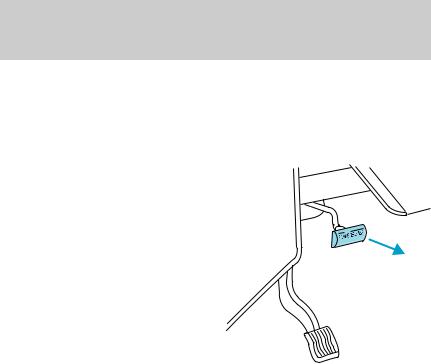
Driving
The parking brake is not recommended to stop a moving vehicle. However, if the normal brakes fail, the parking brake can be used to stop your vehicle in an emergency. Since the parking brake applies only the transmission mounted parking brake assembly, the vehicle’s stopping distance will increase greatly and the handling of your vehicle will be adversely affected.
Push the service brake pedal with your foot and pull the parking brake release handle to release the parking brake.
AUTOMATIC TRANSMISSION OPERATION (IF EQUIPPED) 
Brake-shift interlock
This vehicle is equipped with a brake-shift interlock feature that prevents the gearshift lever from being moved from P (Park) when the ignition is in the ON position unless brake pedal is depressed.
If you cannot move the gearshift lever out of P (Park) with ignition in the ON position and the brake pedal depressed:
1.Apply the parking brake, turn ignition key to LOCK, then remove the key.
2.Insert the key and turn it to OFF. Apply the brake pedal and shift to N (Neutral).
3.Start the vehicle.
If it is necessary to use the above procedure to move the gearshift lever, it is possible that a fuse has blown or the vehicle’s brakelamps are not operating properly. Refer to Fuses and relays in the Roadside emergencies chapter.
30
